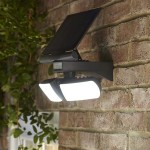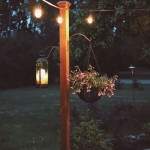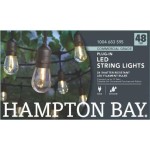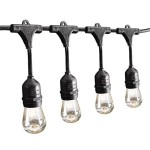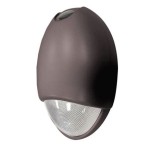Best Outdoor Solar Lamps: A Guide to Illuminating Your Outdoor Space
Outdoor solar lamps offer an energy-efficient and aesthetically pleasing way to illuminate gardens, pathways, patios, and other outdoor areas. They harness the power of the sun, converting sunlight into electricity stored in rechargeable batteries, eliminating the need for complex wiring and reducing electricity bills. Selecting the "best" outdoor solar lamp depends on individual needs and preferences, considering factors like brightness, design, durability, and specific application.
This article provides a comprehensive guide to understanding the different types of outdoor solar lamps available, the key features to consider when making a purchase, and some of the potential benefits and drawbacks associated with their use. This information will enable readers to make informed decisions when choosing the ideal solar lamps for their outdoor spaces.
Understanding Different Types of Outdoor Solar Lamps
The market offers a wide variety of outdoor solar lamps, each designed for a specific purpose and aesthetic. Categorizing these lamps based on their primary function and design helps narrowing the selection process.
Path Lights: Path lights are designed to illuminate walkways and driveways, providing safety and visibility during nighttime hours. These lamps typically have a low-to-medium brightness and are often installed along the edges of paths. They usually feature a simple, unobtrusive design that blends with the surrounding landscape. Path lights are often spike-mounted, allowing for easy installation directly into the ground.
Spotlights: Solar spotlights provide focused illumination for specific areas or objects, such as trees, sculptures, or architectural features. They are generally brighter than path lights and can be adjusted to direct the light beam. Many spotlights feature adjustable solar panels, allowing users to optimize sunlight capture. Furthermore, they are often used for security purposes, highlighting potential hazards or deterring intruders.
Flood Lights: Solar flood lights offer broad, widespread illumination, suitable for larger areas like patios, gardens, or building facades. They provide enhanced security and visibility and are typically brighter than spotlights. Flood lights come in various sizes and lumen outputs, and some models feature motion sensors for automatic activation. Mounting options include wall mounting, pole mounting, and ground mounting.
String Lights: Solar string lights offer a decorative and ambient lighting solution for patios, decks, and pergolas. They consist of a series of small LED bulbs connected by a string, powered by a small solar panel. String lights come in various styles, including fairy lights, globe lights, and lantern lights. They are often used for creating a festive or romantic atmosphere.
Post Lights: Solar post lights are designed to be mounted on posts or pillars, providing illumination for entrances, driveways, and pathways. They often feature a classic or traditional design that complements the architectural style of the home. Post lights provide a clear visual marker and increase safety around walkways and driveways.
Wall Lights: Solar wall lights are mounted on walls, providing illumination for doorways, garages, and patios. They offer a combination of security and aesthetics and are available in various styles, from modern to traditional. They are commonly used in areas where overhead lighting is limited or unavailable. Wall lights can be both decorative and functional, enhancing the overall look and safety of the outdoor space.
Floating Lights: Solar floating lights are designed to float on the surface of swimming pools, ponds, or other bodies of water. They provide ambient lighting and add a unique aesthetic touch to the water feature. These lights are typically waterproof and come in various shapes and colors. This type of light offers a decorative and energy-efficient way to enhance water features.
Key Features to Consider When Choosing Outdoor Solar Lamps
Selecting the right outdoor solar lamps involves careful consideration of several key features to ensure optimal performance, durability, and suitability for specific needs. Evaluating these features will help in making a purchase that provides long-term satisfaction.
Brightness (Lumens): Brightness is measured in lumens, indicating the total amount of visible light emitted by the lamp. The appropriate lumen output depends on the intended use. For path lights, a lower lumen output (10-50 lumens) is generally sufficient, while spotlights and flood lights require higher lumen outputs (100-500 lumens or more) for effective illumination. Choosing the correct brightness is crucial for achieving the desired lighting effect and functionality. Consider the size of the area being illuminated and the level of brightness required for safety and visibility.
Battery Capacity: The battery capacity determines how long the solar lamp will operate on a single charge. Higher battery capacity means longer run times, especially on cloudy days when sunlight is limited. Battery capacity is typically measured in milliampere-hours (mAh). Look for lamps with a sufficient battery capacity to meet the desired operating time, considering the typical weather conditions in the area. Generally, a battery capacity of at least 600mAh is recommended for reliable performance.
Solar Panel Efficiency: The efficiency of the solar panel determines how effectively it converts sunlight into electricity. More efficient solar panels can charge the battery faster and more effectively, even in less-than-ideal conditions. Solar panel efficiency is often expressed as a percentage. Mono-crystalline solar panels are generally more efficient than poly-crystalline panels. Look for lamps with high-efficiency solar panels to maximize performance and ensure reliable operation.
Durability and Weather Resistance: Outdoor solar lamps are exposed to various weather conditions, including rain, snow, sun, and wind. It is vital to choose lamps that are durable and weather-resistant to withstand these elements. Look for lamps made from high-quality materials, such as stainless steel, aluminum, or durable plastics, and with a waterproof rating (IP rating) that indicates their resistance to water and dust. A higher IP rating indicates better protection. Consider the climate and environmental factors in the area when selecting lamps with the appropriate level of weather resistance.
Material and Construction: The materials used in the construction of solar lamps significantly impact their durability and longevity. Stainless steel and aluminum are corrosion-resistant and suitable for coastal environments. Durable plastics, such as ABS or polycarbonate, are lightweight and impact-resistant. The construction quality should also be considered, ensuring that the lamp is sturdy and well-assembled. Examine the seams, joints, and connections to assess the overall build quality.
Design and Aesthetics: Outdoor solar lamps should complement the aesthetic style of the outdoor space. Lamps are available in various designs, from modern to traditional, and in different colors and finishes. Consider the overall look and feel of the garden, patio, or pathway and choose lamps that enhance the visual appeal. The design should also be functional, ensuring that the lamp provides adequate illumination without being visually intrusive.
Ease of Installation: Ease of installation is an important consideration, especially for DIY enthusiasts. Solar lamps should be easy to install without requiring specialized tools or electrical expertise. Spike-mounted lamps, for example, are easy to install in the ground, while wall-mounted lamps may require some basic drilling and screwing. Check the installation instructions and ensure that the lamps come with all the necessary hardware. Clear and concise instructions are crucial for a hassle-free installation process.
Motion Sensor Functionality: Some solar lamps feature motion sensors, which activate the lamp only when movement is detected. This feature can help conserve battery power and extend the operating time. Motion sensors are particularly useful for security lighting, providing enhanced visibility when needed. Adjustability of the motion sensor sensitivity and range should also be considered. Test the motion sensor to ensure it functions reliably and accurately.
Light Color Temperature: Light color temperature is measured in Kelvin (K) and indicates the warmth or coolness of the light. Warm white light (2700-3000K) creates a cozy and inviting atmosphere, while cool white light (4000-5000K) provides brighter, more focused illumination. Choose the light color temperature that best suits the intended purpose and aesthetic preference. Warmer light is often preferred for ambiance, while cooler light is more suitable for security purposes.
Benefits and Drawbacks of Using Outdoor Solar Lamps
Outdoor solar lamps offer several advantages over traditional wired lighting systems, but also have some limitations. Understanding both the benefits and drawbacks is essential for making an informed decision.
Benefits: One of the primary benefits of outdoor solar lamps is their energy efficiency. They utilize renewable solar energy, reducing reliance on fossil fuels and lowering electricity bills. Additionally, they eliminate the need for complex wiring, simplifying installation and reducing installation costs. Solar lamps are also environmentally friendly, producing no greenhouse gas emissions during operation. They are available in a wide range of styles and designs, catering to various aesthetic preferences and applications. Solar lamps also offer increased safety by eliminating the risk of electrical shock associated with wired lighting systems. They can be placed in remote locations that are not easily accessible by electrical wiring, providing illumination where it is most needed.
Drawbacks: The performance of solar lamps is dependent on sunlight availability. On cloudy days or in shaded areas, the battery may not fully charge, resulting in reduced brightness and operating time. Battery life is limited, and batteries will eventually need to be replaced. The initial cost of solar lamps can be higher than that of traditional wired lighting systems. Solar panel efficiency can be affected by dust, dirt, and snow, requiring regular cleaning to maintain optimal performance. The brightness of solar lamps may not be as high as that of wired lighting systems, limiting their suitability for certain applications. In harsh weather conditions, such as extreme heat or cold, the performance and lifespan of solar lamps can be negatively affected.
By carefully considering these key features and understanding the potential benefits and drawbacks, individuals can confidently select the "best" outdoor solar lamps to enhance the beauty, safety, and functionality of their outdoor spaces.

Best Solar Lights On Test In 2024 Bbc Gardeners World

The Best Solar Path Lights Of 2024 According To Testing Bob Vila

Best Solar Garden Lights Guide 2024 Updated

6 Best Solar Lanterns Of 2024 Reviewed

5 Best Outdoor Solar Lights Of 2024 Reviewed

The Best Solar Landscape Lights Of 2024 Popular Science

Best Solar Lights On Test In 2024 Bbc Gardeners World

The Best Solar Garden Lights Of 2024 Digital Trends

7 Outdoor Solar Lights To Brighten Up Your Yard Utopia

The Best Solar Lanterns For Your Garden 2024
Related Posts
